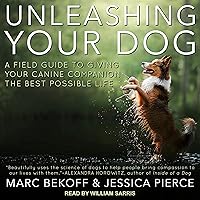Project Blog
Book Review : Unleashing Your Dog, a field guide to giving your canine companion the best life possible
How to live well with your dog

Mara Miele
Beckoff, M. and Pierce, J. (2019) ‘Unleashing Your Dog, a field guide to giving your canine companion the best life possible’, New World Library, Novato California, USA.
This is a delightful book dedicated to people who want to live well with their companion dogs. It is written in a very accessible and enjoyable style, but it is strongly based on recent advances in animal cognition and animal behavioural science. The authors’ overall philosophy towards life with dogs is a great example of anti-speciesism and non-hierarchical thinking, where both humans and dogs can contribute to the quality of the partnership that they establish. It is also a non-sentimental manual for a mutually rewarding co-habitation.
The authors argue that while companion dogs are not ‘held captive’ like wild animals in zoos, in many respects they are also captive animals as there are many constraints they face within a human home and a human-centred world. Here ‘being captive’ means that a dog’s life is not their own, that the forms of their daily existence are shaped by the humans they live with …it does not necessarily mean that they are mistreated or unhappy: Being captive refers to a type of existence, not its quality. It means being confined to a certain human space, one that is not a ‘beastly place’ of your choice. It means that pet dogs lack the ability to choose what they do, who they see, who and what they smell, and what and when they eat. It means, at times, they are forced to do certain tasks asked of them by others.
In order to address the quality of life of companion dogs the authors propose to address a series of freedoms. They draw upon the ‘five freedoms’ concept endorsed by the UK Farm Animal Welfare Council in 1979 for measuring and monitoring the welfare of farm animals, but these have been adapted and expanded to propose a guide for positive interactions with dogs: freedom from thirst and hunger, freedom from pain, freedom from discomfort, freedom from fear and distress, freedom from avoidable or treatable illness and disability but also freedom to be themselves, freedom to express normal behaviour, freedom to exercise choice and control, freedom to frolic and have fun, freedom to have privacy and ‘safe zones’.
While the first five freedoms (freedom from) are addressing the risks of poor welfare, the second set of freedoms (freedom to) are more clearly addressing aspects of animal life that would lead to higher quality of life and claim that even the most well-cared-for dogs may experience deprivations of which their owner/carer is not aware simply because most people who want to live with dogs do not know much about dog behaviour. For example, the authors point out how different dog culture is from human culture (human: butts and groins are private areas and not to be touched or smelled by strangers/ dog: sniffing butts and groins is perfectly natural behaviour. It is like greeting someone by saying ‘how do you do?’ and getting the answer….) and what it is like to be a dog in a human world when you have a different sensorium. And it is through an examination of how dogs experience the world through their senses that they support their argument about the importance of addressing their proposed ten freedoms.
Then the book presents the most recent research findings about the role and use of different senses in dogs. They discuss how different the senses are in dogs compared to humans and what are the main risks for the quality of life of dogs if these differences are not taken into consideration: Doggy smell is comforting for dogs, washing them often or washing / adding deodorant to their beds or toys is not welcome; touch needs to be negotiated, not all dogs like to be hugged, privacy is important, dogs need a safe place….They conclude by pointing to the importance of play for dogs and the need to offer them plenty of opportunities to play in order to develop social skills. Play is a kaleidoscope of the senses and they are all involved in playing, even if to different degrees. Play, defined ‘as a social activity directed towards another individual in which actions from other contexts are used in modified forms and in altered sequences’
, is seen as crucial for dogs’ happiness and well-being but it also performs other crucial functions, as it helps to satisfy biological, emotional, social and cognitive needs and is necessary to develop the social skills they need to be ‘card-members’ of their species but also to cope with and live better with their humans.
References
Freedoms, F. (1979). Farm Animal Welfare Council. Internet site:
https://webarchive.nationalarchives.gov.uk/20121010012427/http://www.fawc.org.uk/freedoms.htm (Accessed April 22nd 2020).
Philo, C., & Wilbert, C. (2004). Animal spaces, beastly places. In Animal spaces, beastly places (pp. 15-50). Routledge.
